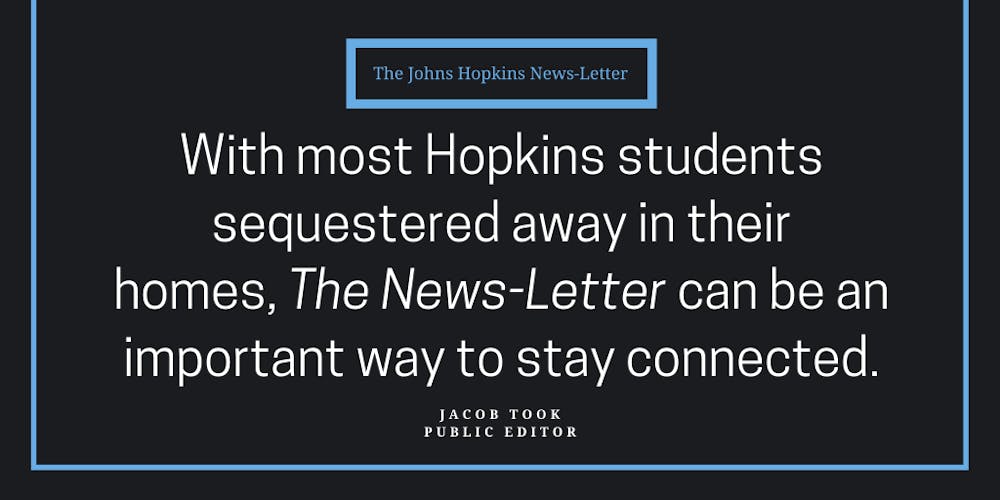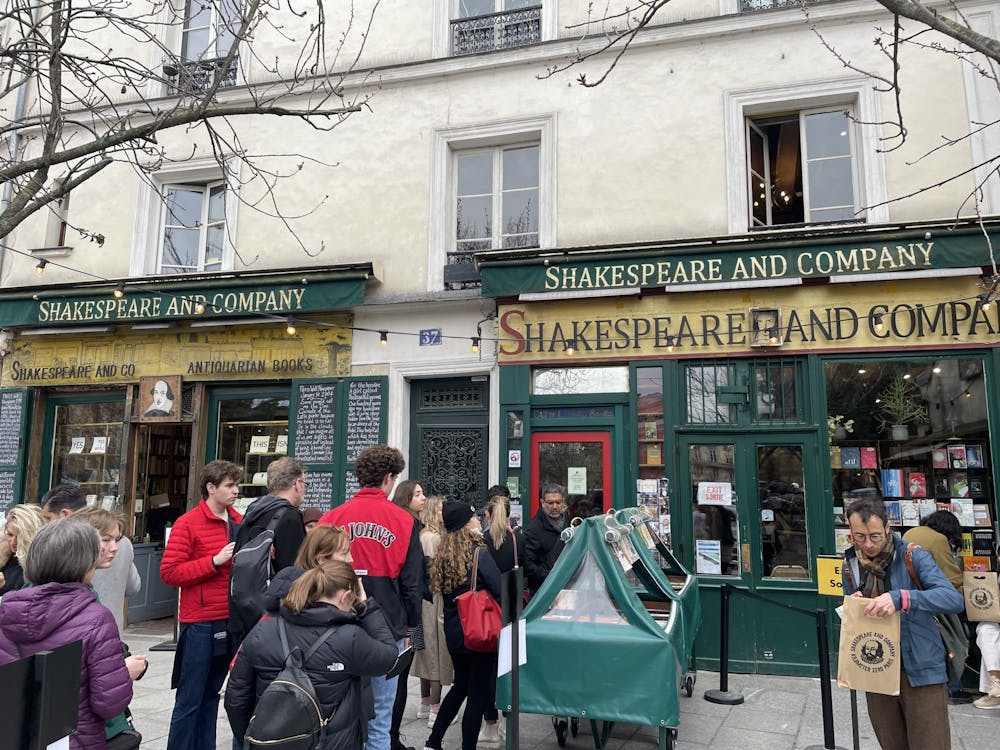
Restrictions on student groups. Spring Fair restructuring. Progress on (and ongoing opposition to) a private police force. Not long ago, we thought these were among the year’s biggest stories. Then came one headline to top them all: Students sent home.
After the initial announcement that in-person classes would be suspended through April 12 due to the outbreak of the novel coronavirus (COVID-19), students across campus connected with friends, families and peers to make important decisions: whether to carry out spring break plans, when to return home, how to transition to class (and life) online.
News-Letter Editors-in-Chief Amelia Isaacs and Sarah Y. Kim saw the announcement from University President Ronald J. Daniels during a meeting of the editorial board. It didn’t take them long to agree on temporarily halting the paper’s print production.
“I was not super convinced that it was going to happen,” Kim said, recalling uncertainty about whether Hopkins would suspend classes in response to the pandemic. “Then it happened on Tuesday night, so we sat down for about 15 minutes and just made that decision there.”
They persevered with that week’s issue, which hit the stands less than two days later. Kim and Isaacs agreed that it was important to preserve a tactile record of such a significant story.
“A big thing that we pride ourselves on is being a record of what happens at the University, being a memory of what’s happened,” Isaacs reflected. “In our lifetimes, or at the very least in our time at Hopkins, this is the biggest thing that’s happened.”
As the pandemic disrupts nearly every part of life, News-Letter editors have sought to document the Hopkins community’s adjustments to a new normal while acclimating themselves to new standards of production.
When Daniels shared the decision that Tuesday night, many editors had already finished up their work for the week, and production proceeded almost as usual. But in the past week, editors adjusted to a staggered online schedule, connecting virtually to coordinate the stages of writing, editing and publication.
While Isaacs and Kim said that meetings proceeded smoothly via video chat, they agreed that having editors scattered around the world rather than together in the Gatehouse during one night of production made it harder to ask questions or talk through edits to a piece. That’s not to mention the sense of community that’s now missing: Watching someone’s cursor on a Google Doc is very different from seeing their face.
Adapting quickly, it was essential to keep structures in place to help online production feel familiar to editors. Isaacs and Kim checked in with each section to establish reasonable expectations for content. They also had to make sure the paper could preserve essential parts of production throughout the week, like the process of copy reading, without overloading editors who are used to most of their work being centralized on one or two days.
Underpinning each change editors make to adjust to new ways of production is an eye to the future.
“When all this is over, will we have a different schedule for publishing things in print and publishing things on the website?” Kim wondered, adding that they would revisit this question as the semester progresses. She and Isaacs regard the rest of the semester as a trial run of web-first production, albeit one that was forced upon them.
In a piece last semester, I touched on some advantages of moving to a web-first content formula: giving editors more flexibility with sources and writers, shifting to be more consistent with how publications engage with readers in the digital age and, in the long term, better preparing the paper for potential industry-wide ruptures which could very well reinvent journalism as we know it.
But in the short term, asking editors to reinvent their approach to the paper in the midst of a global pandemic might seem like a tall order. Both Kim and Isaacs emphasized that they sought to place the needs of the staff first.
“Now is a really stressful time for everyone. We don’t want to put pressure on people in a way that they can’t handle, and we know that they weren’t elected to this position thinking that they would have to do it from home,” Isaacs said. “But mostly, in terms of feedback we’ve got from editors, it’s that the paper gives them a sense of normalcy in a really weird time.”
Isaacs shared this sentiment, joking that replying to Slack messages can be a calming reminder of normalcy.
Through Slack check-ins, Isaacs and Kim talked with sections about how to adjust their coverage to respond to the outbreak. News & Features followed the story tightly, publishing stories throughout spring break as news broke about further policy decisions from Hopkins administrators responding to COVID-19.
Reconnecting after break, many sections had to reevaluate their typical coverage in light of the outbreak’s effects on campus, in Baltimore and around the world. Sports, for example, can’t cover game recaps during a cancelled season. Typical Your Weekend content does not conform to standards of social distancing. I recently wrote about Arts & Entertainment shifting to more coverage of events on campus and in Baltimore, and other sections like Science & Technology have pursued similar goals this year.
Having already stepped up their reporting, this year’s editors and their writers are uniquely well-positioned to cover the effects of COVID-19 on campus and in the city.
“Even though they aren’t writing about what they normally would be writing about, there’s something important for each section to be covering,” Isaacs said. “How is this affecting students? We’ve asked editors to see if they can take that view — not for all of their pieces, obviously, but for at least some of them.”
As editors publish their first push of coverage related to COVID-19, other stories will find their ways back into the mix. With most Hopkins students sequestered away in their homes, The News-Letter can be an important way to stay connected. Learning about how other students are experiencing the pandemic may be part of that, but other content — Voices columns, album reviews, op-eds about the 2020 election — can hopefully help preserve an echo of normal life.
That said, the scale of the COVID-19 story feels all-consuming.
“As a paper, we try to reflect what the community is talking about and really concerned about, and right now coronavirus is really on everyone’s minds,” Kim said. “We’ve never had a moment like this in our time at Hopkins, and maybe for the next several decades we won’t, and it just reminds us how important journalism, especially a student newsroom, can be at a time like this.”
With the end of the year fast approaching, a fact that might be especially sobering for my fellow seniors, Isaacs and Kim are looking ahead to next year.
They delayed elections to determine next year’s editors, originally scheduled for this week, to give candidates more time to consider their decisions amidst the general turmoil. That leaves less time for shadowing, which normally takes place throughout the final month of the semester as editors-in-training settle into their new roles.
But it’s unclear how training will proceed virtually. Isaacs and Kim said editors would schedule video conferences with candidates, but added that they would consider holding a few days of intensive training before the start of the fall semester to focus on layout and other processes specific to print production.
Throughout the process of preparing for next semester, incoming and outgoing editors should question whether a universal return to the paper’s “normal” is the best way forward. Firming up what currently feel like short-term changes into permanent parts of web-first production could help the paper address some long-term challenges, such as easing the burden placed on one exhausting night of production each week.
Amidst all these changes, though, Isaacs and Kim hope students will take comfort in familiar parts of the paper. Corgi cartoons in your Facebook feed might be small pieces of joy. Section editors will continue working tirelessly to maintain a range of diverse content representing student voices. The paper still plans to publish a spring magazine.
“These things hopefully do bring moments of — not relief, that’s not the right word,” Isaacs said. “But little moments of lighthearted content which hopefully are helpful and nice for people to see in the midst of everything that’s happening.”
We want you to be part of this conversation! We encourage our readers to email publiceditor@jhunewsletter.com with questions or comments about our practices and published content.





